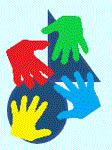
|
Washington State Math Olympiad
Hints and Solutions
2007 Grade 6 Probability & Statistics
|
 |
| Problem |
Solution |
|
1) Onita is pretty sure her semester GPA will be 3.8 for the 6 credits she's taking. Her previous
cumulative GPA was 3.5 for the 6 credits she already had from the previous semester. What will be
her new cumulative GPA? Round to the nearest hundredth.
|
Take the average of the 2 semester GPAs =
(3.5 + 3.8)/2 = 3.65
|
2) Fill in the blanks in the list of numbers such that the only mode for the list will be 9 and the
median will be 15.
4, 9, ___, ___, 13, ___, 17, 23, 23, 28
|
1. Since there are two 23s in this list, the number of 9s must be 3 to make it the mode.
2. Since there are 10 numbers in this list, the median must be the average of the middle 2 numbers.
3. What number, averaged with 13 is 15?
This number is (13 + 17)/2 = 15.
4. The completed list is:
4, 9, 9, 9, 13, 17, 23, 23, 28
|
3) Joe's dad tells Joe he can have the bag of fruit chews he's holding if he can solve this riddle.
There are four flavors: strawberry, orange, lemon, and cherry. There are 5 strawberry chews. The
probability of getting orange is 1/7. The probability of getting a lemon is 2/7. What is the fewest
number of cherry chews that could be in the bag? |
1. Add the probabilities of orange and lemon chews =
1/7 + 2/7 = 3/7
2. Subtract this from 1 = 4/7. This is the probability of a strawberry or a cherry chew.
3. Using this, compute the total number of chews =
Let n = the number of cherry chews and t = total number of chews
The equation for the total number of chews is:
5 + n = (4/7) t
Starting with n = 1, increase the number of cherry chews until you get a whole number for the total number of chews.
n = 1: 5 + 1 = 4 t / 7; 42 = 4t; t = 11.5
n = 2: 5 + 2 = 4 t / 7; 49 = 4t; t = 24.5
n = 3: 5 + 3 = 4 t / 7; 56 = 4t; t = 14
|
|